By Diana Lee @only1phoenixx
Many of us that enjoy spending time in nature love learning more about the spaces we play in. Whether it’s learning about new paddling spots to launch from or about the wildlife we’ll see along the way, we outdoor enthusiasts typically want to get more out of our adventures!
When you go on an Indigenous-guided tour, be prepared to see, explore, and appreciate the lands and waters we play in from a different lens by recognizing and supporting Indigenous People’s deep connections with these spaces.
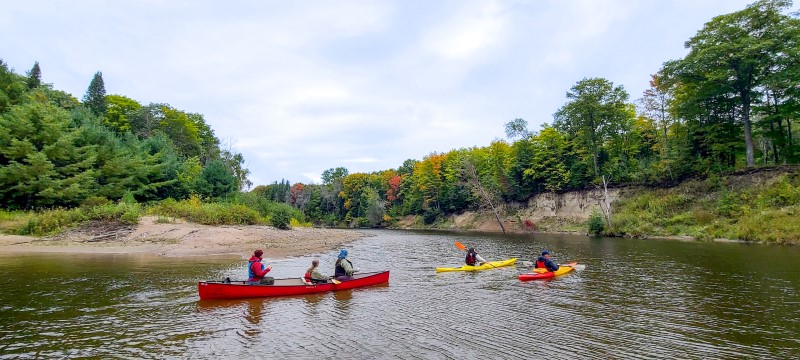
On a recent trip to Sault Ste. Marie in Algoma Country, home of the Anishinaabe since time immemorial, I spent some time with Thrive Tours, an Indigenous-owned and operated guided ecotourism company, and the experience went above and beyond a paddling tour.
As a non-Indigenous person, I’m always excited to learn more about our amazing province, country, and world. I’ve been lucky enough to join in on a few Indigenous travel adventures from Inuvik, Northwest Territories, to Puvirnituq, Quebec, and I’m happy to share a few highlights from my paddling trip and why you should plan your next adventure with an Indigenous-led tourism operator.
Whether you’re visiting Sault Ste. Marie (traditionally known as Baawaating), or a local, it’s always fun discovering new paddling spots in and around the city. As a stand-up paddleboarding (SUP) aficionado, I bring my paddleboard on all my road trips and travels. I was excited to learn I could BYO (bring your own) SUP for this Thrive Tours paddling adventure!
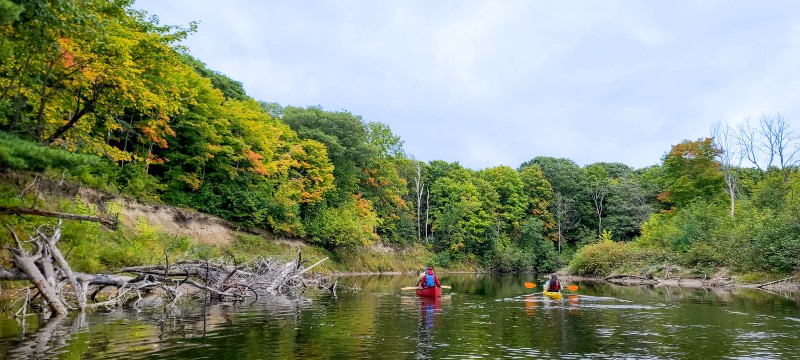
Our first stop was at Thrive Tours’ home base in the Soo, where I met the owners and operators, Amanda (Biimskoonkwaat) and Brad (Ozhaawashkwaa Animikii). Together, they adventure all year round, offering guided canoe, kayak, hiking, and snowshoeing while promoting and maintaining local Indigenous practices and philosophies.
After chatting about what we felt like doing – canoeing, kayaking, or stand-up paddleboarding (SUP), we packed up everything (yes, everything, haha!) We headed to Garden River, located in Garden River First Nation. I learned that this is a sacred area, and a guided tour is a great way to experience this waterway.
Before launching our boats and board, we began by offering Tobacco to the water, a sacred way to connect with all living things. Brad shared the importance of Semah, the Anishinaabemowin word for Tobacco, “when we place Tobacco in our left hand, it symbolizes the closeness of that medicine to our heart. When we transfer those good thoughts and meaningful intentions into the Semah and place it in the water, we connect with all our ancestors and creation itself.”
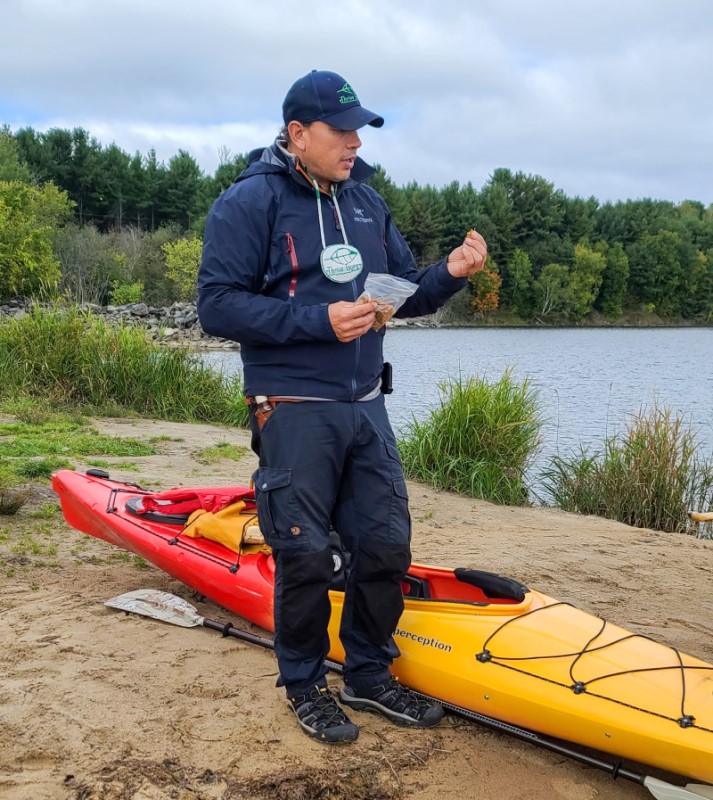
Seeing wildlife always sparks joy and the Thrive Tours team combined the sightings with Anishinaabe teachings right on the water. Seeing eagles, migizi in Anishinaabemowin, swooping down from the trees in front of us was incredibly special. Eagles also symbolize love, or zaagi’idiwin, as part of the 7 Grandfather teachings.
As we continued to paddle, the occasional splash of salmons jumping out of the water kept me excited about what we would see (and learn about) around the next bend of the meandering river.
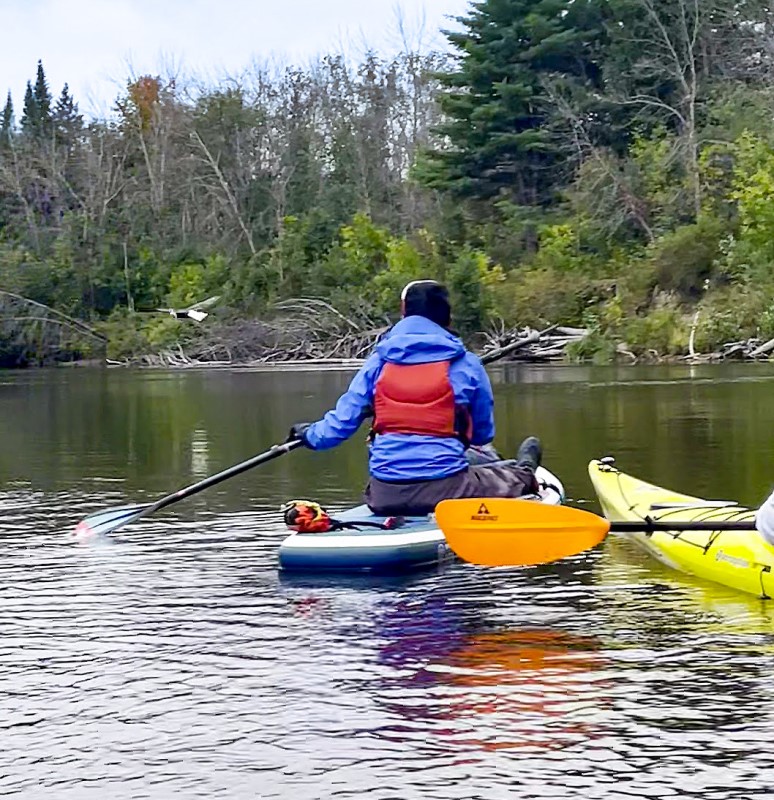
When it was time to take a break, we enjoyed warming up by a mini campfire, with snacks and great conversations while sipping warm Cedar Tea.
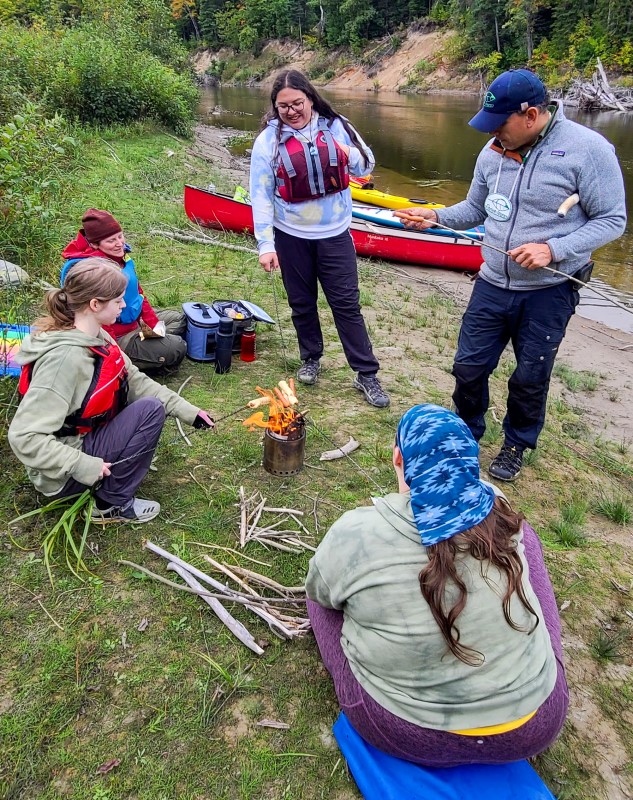
During this tour, I got to chat with Lucia Laford, a local Indigenous artist, educator and one of the Thrive Tour guides. Lucia leads a Paddle & Paint Woodland-style painting workshop where participants can create their own nature-inspired painting while out in nature! Lucia also teaches Anishinaabe Art and Material Practices at Algoma University.
“Woodland style is about visualizing the connection and relationships between people, animals, spirits, and nature. I paint my way of life, the Anishinaabe way, which includes ceremony and spirituality, but also my connection to the land and the plant, tree, and animal nations. In this way, my work is completely inspired by nature and the love and respect I feel towards Aki (the earth), Nibi (the water) and all things in creation.
The Paint & Paddle workshop is about connecting with yourself on the water and the land. Woodland art helps deepen that connection by exploring the relationships and personal kinship we have to life around us. We [Thrive Tours] helps facilitate the joy of being on the land and water, and we do so in a safe, respectful, and sustainable way. When paddling, we talk about the concepts in Woodland-style art while sharing Indigenous perspectives and teachings. Paddling and being able to touch the water and land that we are talking about serves as an incredible inspiration when painting!”
– Lucia Laford, Thrive Tour Guide, Woodland style painter and Indigenous Arts educator
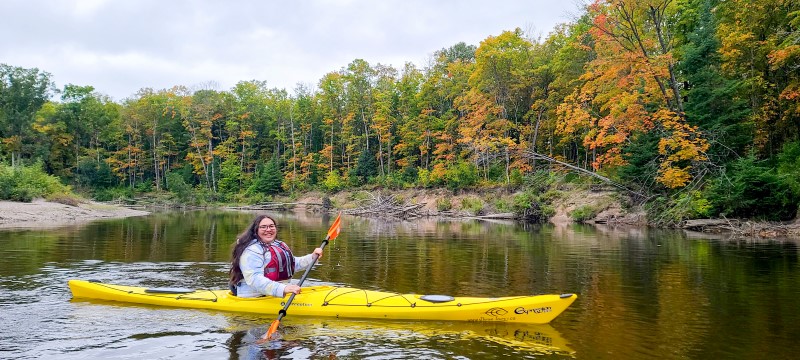
For many Indigenous People, music was a way of storing ecological, ancestral, and traditional knowledge and teachings. Passing along that knowledge was often done through stories and songs.
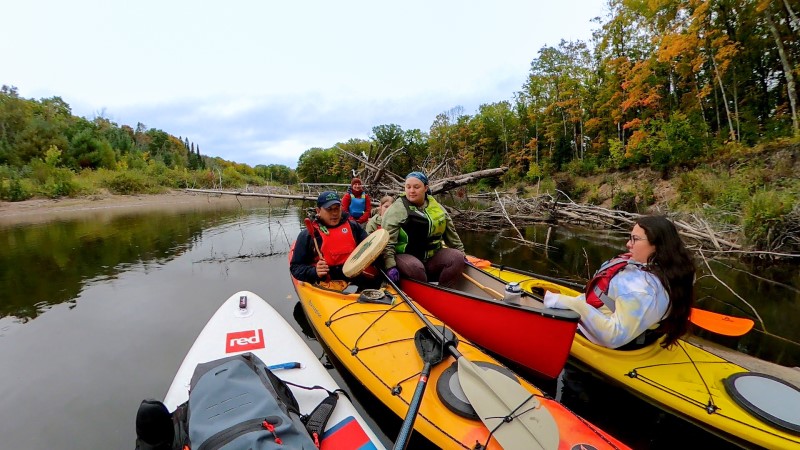
The gentle current carried us along the river while Amanda and Brad, a powwow singer and member of the Black Bull Moose Singers, shared a few honour songs for women and all of creation. Lucia also shared a Water Song*. The lyrics and varied tempo beautifully represent and honour water – from fast-moving rapids to the steady slow flow of a river, like the Garden River we were floating along. We were all invited to sing along and celebrate being on the water.
While I had no expectations for the tour and was open to going with the flow of Thrive Tours, the way we concluded our paddling adventure was incredibly moving. When I asked if they do this for every tour, Amanda explained, “while every experience [with Thrive Tours] unfolds uniquely, we consistently incorporate physical, emotional, mental, and spiritual aspects. Every adventure includes cultural teachings, Indigenous food sharing, nature-based activities, and First Nations ceremonies.”
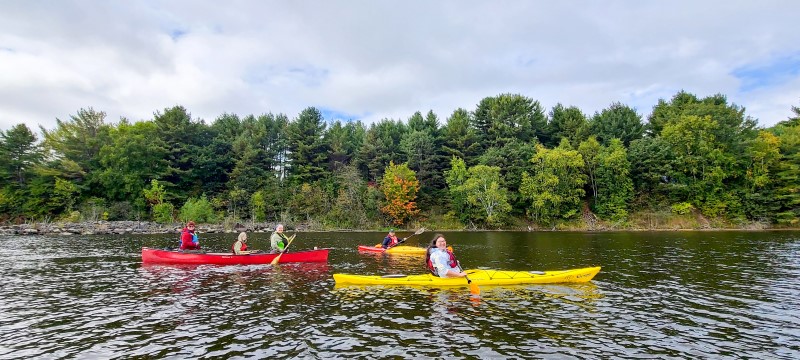
Authentic Indigenous-led travel experiences can help share the stories, histories, and perspectives we don’t get to hear more often. What we can do as allies is to help support that by taking these tours and being open to learning. These excursions that combine outdoor recreation with learning education alongside an Indigenous guide lead to more consideration, respectful, responsible, and meaningful future adventures, whether we travel solo or with company. Travel experiences like this are a step towards taking us beyond land acknowledgements through active participation and ongoing learning, all while adventuring in the spirit and continuous practice of reconciliation.
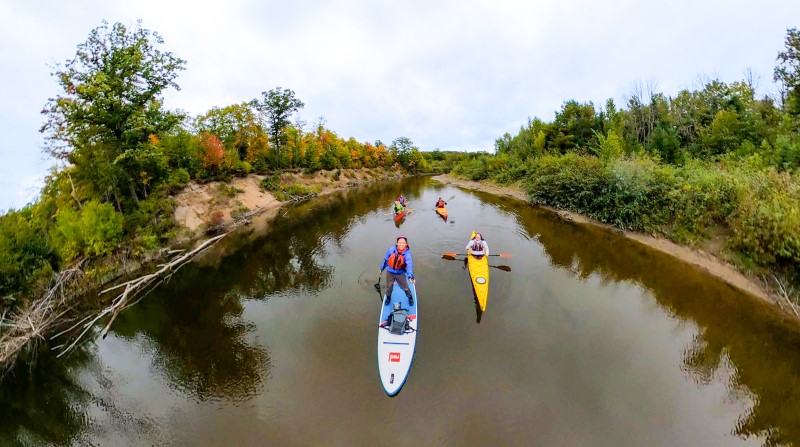
Thank you, Amanda, Brad, and Lucia, for the unforgettable time in Sault Ste. Marie. I look forward to seeing you again soon (hopefully in winter, my favourite season!)
Thrive Tours
https://www.thrivetours.ca/about
For more Indigenous-owned or led travel and adventure ideas:
Recommended resources and further reading:
Diana Lee lives for adventure, the great outdoors, and stand-up paddleboarding (SUP)! She is a certified ISA SUP Instructor, a librarian, and a reporter for Get Out There Magazine. Find out what she’SUP to @only1phoenixx on Instagram and Twitter.
By Conor Mihell
It’s no surprise that a community located in the heart of the Great Lakes would embrace all forms of paddlesports. Not only is Sault Ste. Marie the gateway city for some of the best coastal sea kayaking and wilderness canoeing in Canada, it also boasts amazing options for paddling minutes from downtown. Regardless if you’re passionate about standup paddleboarding, canoe tripping, sea kayaking, whitewater or recreational kayaking, there’s something for you in Sault Ste. Marie.
The Sault College Waterfront Adventure Centre is a community hub on the shore of the St. Marys River. Not only does the gorgeous facility feature a cafe with amazing views, the Waterfront Adventure Centre rents canoes, kayaks and standup paddleboards to explore the historic waterway that has always been central to Sault Ste. Marie’s raison d’etre. Evening is the best time of day for a paddleboard tour on the St. Marys River. Head east (downstream), past the Pine Street Marina, hugging the shore to appreciate the wildlife-rich wetlands of Bellevue Park, watching for ducks, mink and beaver. Rounding the isthmus of Topsail Island provides a new perspective on the city’s most popular park. If you time it right you’ll be graced with a spectacular sunset over the International Bridge on your way back.
Thrive Tours, a local Indigenous nature-based tour operator, offers guided canoe trips from the Waterfront Adventure Centre. These beginner-friendly outings share the full story of how the St. Marys River has supported life since time immemorial.
A downriver trip on the Goulais River, located just north of Sault Ste. Marie, is a springtime rite of passage for whitewater paddlers. This section of river requires high water, and the section from Mountainview Lodge on Highway 556 to the Highway 552 bridge can be done in as little as 4 hours thanks to a steady current. It’s best to make it a day trip to enjoy the Goulais’s soaring, pine-clad hills and great wildlife, including moose, waterfowl and beaver. This section includes Class I and II rapids, as well as plenty of swift water, making it suitable for novice whitewater paddlers–just make sure you travel with companions and dress for cold water temperatures. Stay at the nearby Bellevue Valley Lodge and pack a lunch to enjoy on one of the Goulais’s many gravel bars. As water levels decrease in late May and early June this section is great for anglers, with abundant walleye and smallmouth bass, as well as the possibility of rainbow- and brook trout.
Forest the Canoe offer guided nature tours on the lakes and rivers in the area, as well as on Lake Superior.
You won’t find a more remote–and picture perfect–retreat than Norm’s Cabin, tucked away in the Precambrian hills of the Algoma Highlands, north of Sault Ste. Marie. This off-grid cabin is located in Goulais River, a half-hour drive north of Sault Ste. Marie, and is accessible only by food or mountain bike. Rental comes with access to a canoe, and the freedom to explore gem-like lakes atop the rooftop of Ontario. Norm’s is popular for couples, families and getaways with friends. Contact Blaq Bear Eco Adventure Routes to plan your stay.
The hamlet of Gros Cap at the end of Highway 550, only 20 minutes west of Sault Ste. Marie, marks the eastern terminus of Lake Superior. An official launch on the Lake Superior Water Trail (a segment of the Trans Canada Trail) includes an accessibility dock, outhouses, picnic area and kayak storage locker. Paddling west provides an immediate glimpse of Lake Superior’s rugged shoreline: you’ll encounter spectacular cliffs, gravel beaches and a vast, open horizon along the 10-km section to Red Rock. Be sure to check the weather conditions in advance; this exposed stretch of shoreline is suitable for experienced paddlers only, with sea kayaks, sprayskirts and safety gear to mitigate the risk of cold water.
Central Algoma is a bucolic landscape of maple, oak and pine forests and small inland lakes, just east of Sault Ste. Marie. There are several public parks accessible via Highway 638, a quiet secondary route between Echo Bay and Bruce Mines, with great options for canoeing and recreational kayaking on calm and sheltered water. Visit Old Mill Beach Park on Rock Lake to discover a family-friendly waterfront for swimming and quiet paddling at the mouth of the meandering Thessalon River; this area is especially attractive to birders and naturalists, with a wide variety of song- and shorebirds and aquatic mammals. The Central Algoma Freshwater Coalition has produced an adventure map highlighting paddling and other outdoor activities throughout the region.
It’s amazing to discover a quiet, scenic, wilderness canoe route on Crown land barely 30 minutes from downtown Sault Ste. Marie. The Jarvis Circle Route is a perfect long-weekend getaway for novice and intermediate paddlers. The journey begins at a small public launch on Northland Lake, located off of Highway 556. A series of rugged portages (watch for discrete yellow signs to mark most) links nearly a dozen secluded lakes with many options for primitive camping, including Jarvis, Reserve and Crooked lakes—all of which boast excellent fishing for trout. This is a great area to practice your canoe tripping skills and get a taste of the wilderness of Northern Ontario.
For more information about paddling in Sault Ste. Marie, visit our Watersport page. For information about paddling in Algoma Country click here!